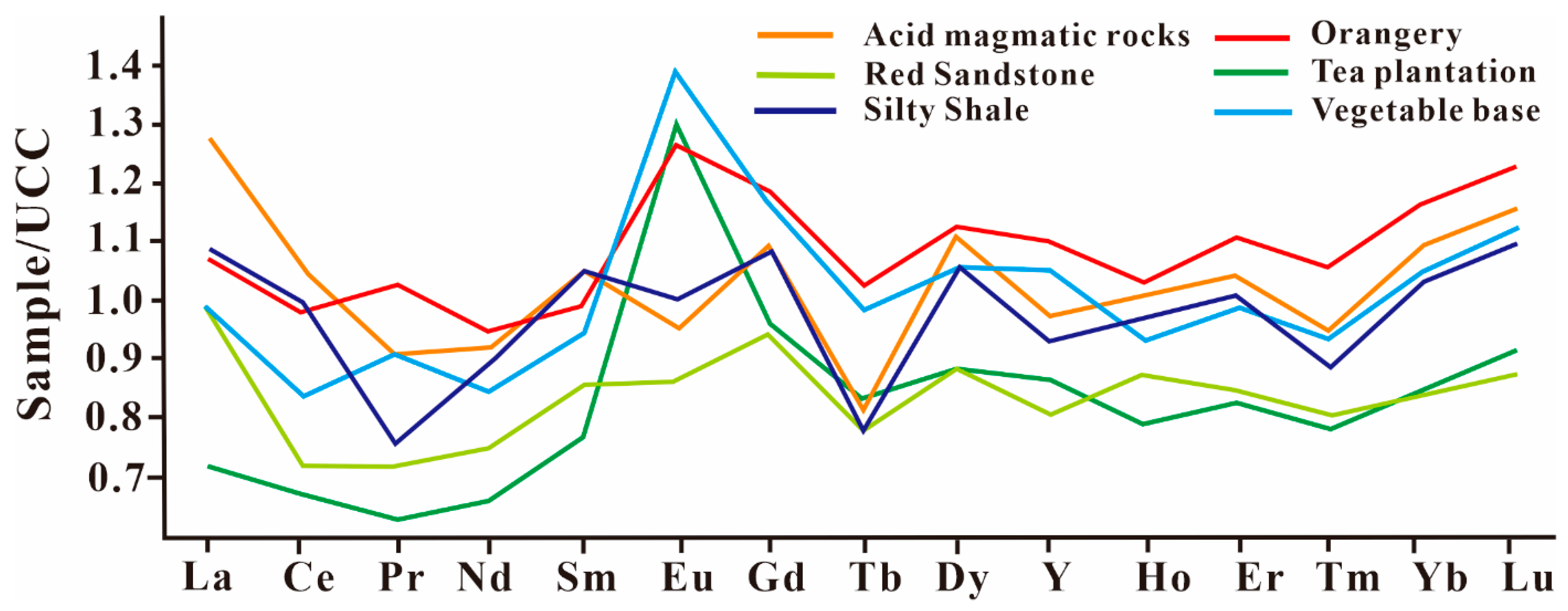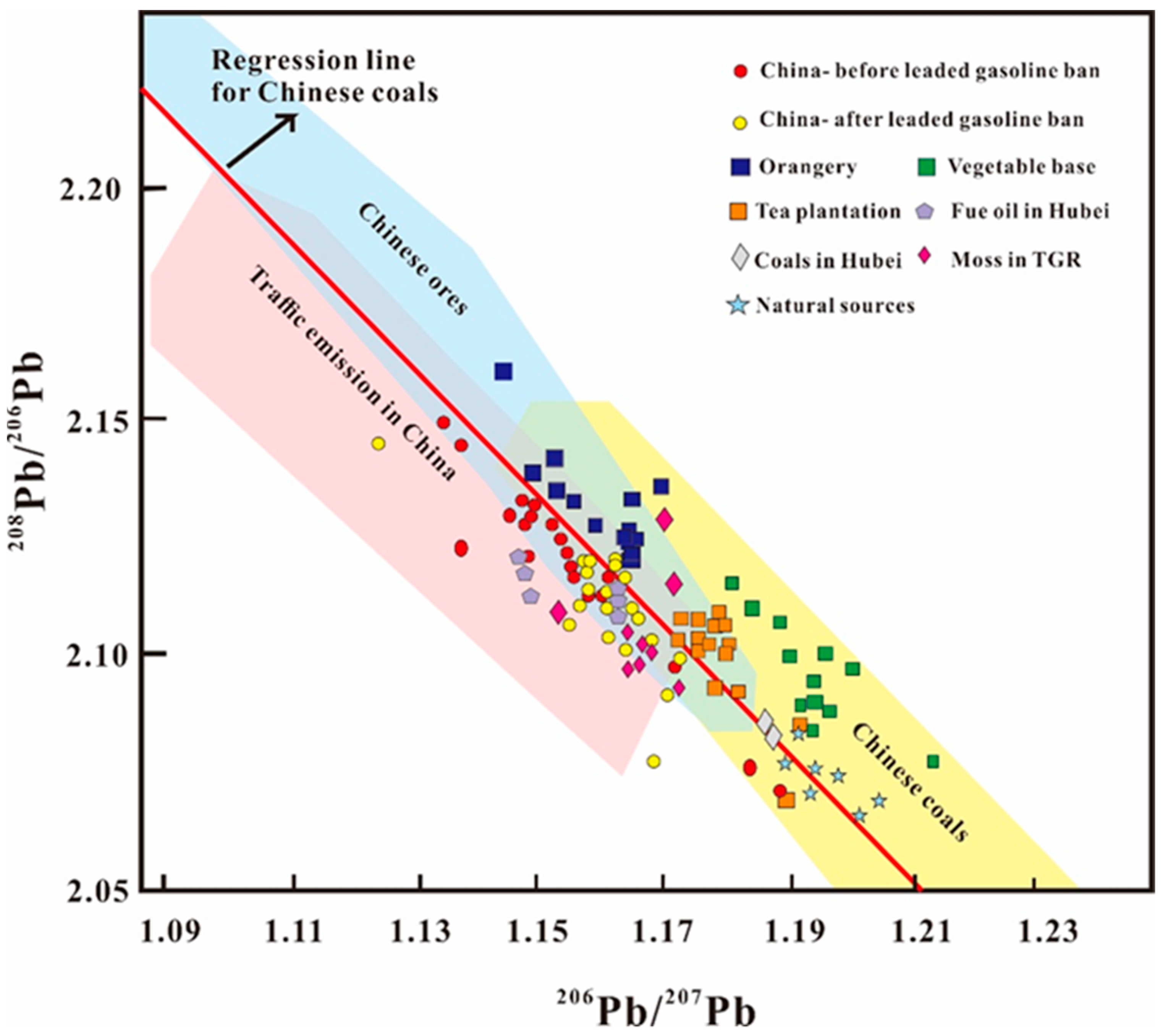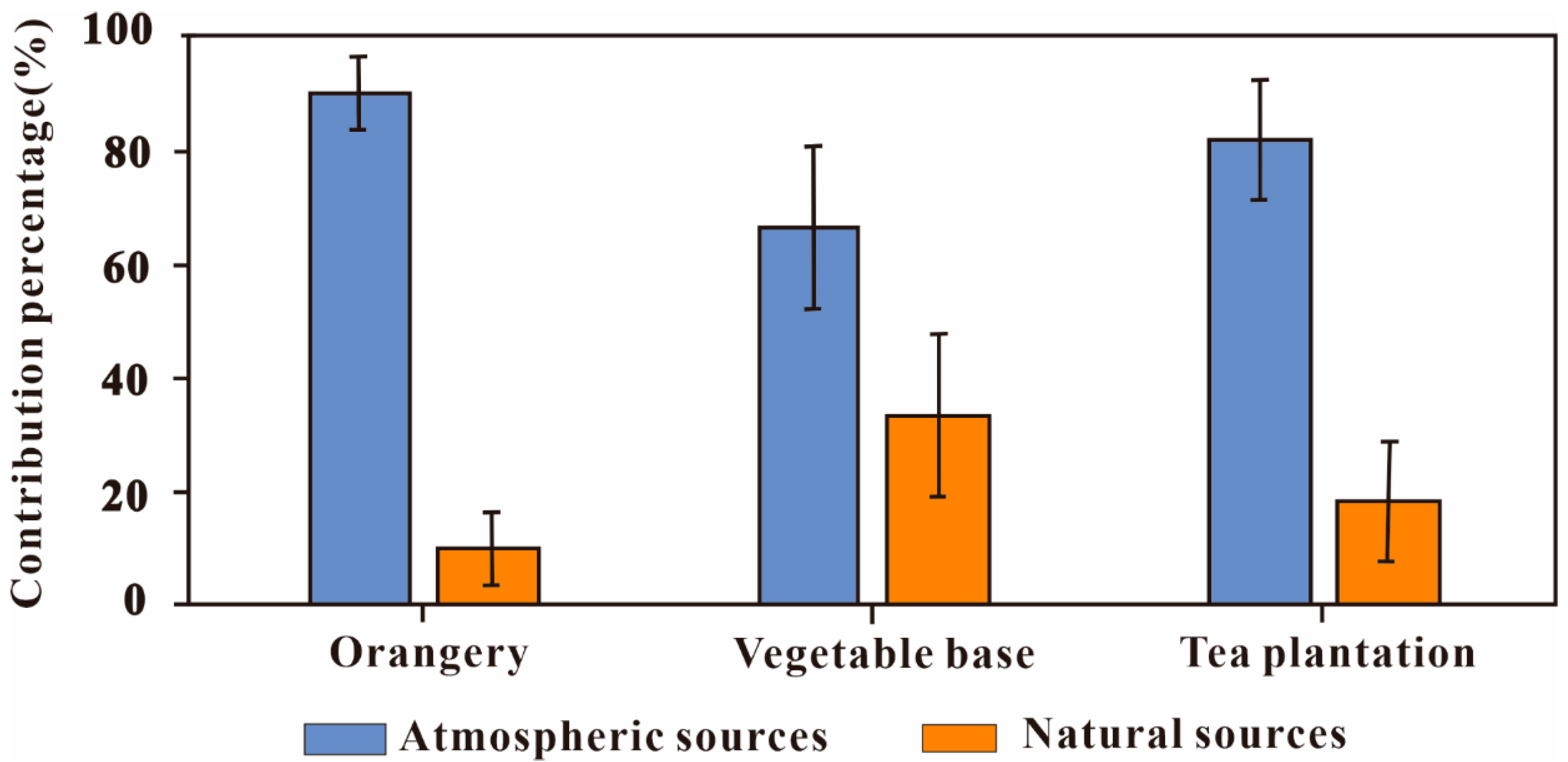Application of Pb Isotopes and REY Patterns in Tracing Heavy Metals in Farmland Soils from the Upper-Middle Area of Yangtze River
Abstract
1. Introduction
2. Materials and Methods
2.1. Study Area and Sample Collection
2.2. Chemical Analysis
2.3. Rare Earth Elements and Yttrium (REY) Methods
2.4. Source Apportionment of Soil Using Stable Pb Isotopes
2.5. Statistical Analysis
3. Results and Discussion
3.1. Distribution of Heavy Metals in Different Farmland Soil Types
3.2. Rare Earth Elements and Yttrium (REY)
3.3. Pb Isotopes in Soils from Different Farmland Types
3.4. Source Apportionment of Heavy Metals in the Soil of Different Farmland Types
4. Conclusions
Supplementary Materials
Author Contributions
Funding
Institutional Review Board Statement
Informed Consent Statement
Data Availability Statement
Conflicts of Interest
References
- Li, Z.Y.; Ma, Z.W.; van der Kuijp, T.J.; Yuan, Z.W.; Huang, L. A review of soil heavy metal pollution from mines in China: Pollution and health risk assessment. Sci. Total Environ. 2014, 468–469, 843–853. [Google Scholar] [CrossRef]
- Wang, P.; Li, Z.; Liu, J.; Bi, X.; Ning, Y.; Yang, S.; Yang, X. Apportionment of sources of heavy metals to agricultural soils using isotope fingerprints and multivariate statistical analyses. Environ. Pollut. 2019, 249, 208–216. [Google Scholar] [CrossRef] [PubMed]
- MEPC (Ministry of Environmental Protection of China); MLRC (Ministry of Land and Resources). National Soil Pollution Survey Communique 2014. Available online: http://www.gov.cn/xinwen/2014-04/17/content_2661765.htm (accessed on 17 November 2022).
- Hou, D.Y.; Li, F.S. Complexities surrounding China’s soil action plan. Land Degrad. 2017, 28, 2315–2320. [Google Scholar] [CrossRef]
- Rezapour, S.; Samadi, A. Soil quality response to long-term wastewater irrigation in Inceptisols from a semi-arid environment. Nutr. Cycl. Agroecosystems 2011, 91, 269–280. [Google Scholar] [CrossRef]
- Liu, Y.B.; Ma, Z.H.; Liu, G.N.; Jiang, L.; Dong, L.M.; He, Y.; Shang, Z.H.; Shi, H.D. Accumulation risk and source apportionment of heavy metals in different types of farmland in a typical farming area of northern China. Environ. Geochem. Health 2021, 43, 5177–5194. [Google Scholar] [CrossRef]
- Gupta, V.K.; Yola, M.L.; Atar, N.; Ustndag, Z.; Solak, A.S. A novel sensitive Cu (II) and Cd (II) nano-sensor plat-form: Graphene oxide terminated p-aminophenyl modified glassy carbon surface. Electrochim. Acta 2013, 112, 541–548. [Google Scholar] [CrossRef]
- Alloway, B.J. The origins of heavy metals in soils. In Heavy Metals in Soils; Alloway, B.J., Ed.; Wiley: New York, NJ, USA, 1995; pp. 29–39. [Google Scholar]
- Rezapour, S. Response of some soil attributes to different land use types in calcareous soils with Mediterranean type climate in north-west of Iran. Environ. Earth Sci. 2014, 71, 2199–2210. [Google Scholar] [CrossRef]
- Nael, M.; Khademi, H.; Jalalian, A.; Schulin, R.; Kalbasi, M.; Sotohian, F. Effect of geo-pedological conditions on the distribution and chemical speciation of selected trace elements in forest soils of western Alborz, Iran. Geoderma 2009, 152, 157–170. [Google Scholar] [CrossRef]
- Hseu, Z.-Y.; Zehetner, F.; Ottner, F.; Iizuka, Y. Clay-Mineral Transformations and Heavy-Metal Release in Paddy Soils Formed on Serpentinites in Eastern Taiwan. Clays Clay Miner. 2015, 63, 119–131. [Google Scholar] [CrossRef]
- Liu, M.; Yang, Y.; Yun, X.; Zhang, M.; Wang, J. Concentrations, distribution, sources, and ecological risk assessment of heavy metals in agricultural topsoil of the Three Gorges Dam region, China. Environ. Monit. Assess. 2015, 187, 1–11. [Google Scholar] [CrossRef]
- Bai, L.Y.; Zeng, X.B.; Su, S.M.; Duan, R.; Wang, Y.N.; Gao, X. Heavy metal accumulation and source analysis in green-house soils of Wuwei District, Gansu Province. China. Environ. Sci. Pollut. Res. 2015, 22, 5359–5369. [Google Scholar] [CrossRef]
- Subbiah, S.; Natarajan, M.; Narayanan, N.M.; Rajagopal, S. Heavy metal content of black teas from south India. Food Control. 2008, 19, 746–749. [Google Scholar]
- Ishaq, M.; Sultana, N.; Ikram, M.; Iqbal, A.; Shah, F.; Hamayun, M.; Hussain, A. Occurrence of heavy metals and pesticide residues in tomato crop: A threat to public health. Arab. J. Geosci. 2020, 13, 627. [Google Scholar] [CrossRef]
- Chen, H.; Teng, Y.; Li, J.; Wu, J.; Wang, J. Source apportionment of trace metals in river sediments: A comparison of three methods. Environ. Pollut. 2016, 211, 28–37. [Google Scholar] [CrossRef]
- Chen, L.; Zhou, S.; Wu, S.; Wang, C.; Li, B.; Li, Y.; Wang, J. Combining emission inventory and isotope ratio analyses for quantitative source apportionment of heavy metals in agricultural soil. Chemosphere 2018, 204, 140–147. [Google Scholar] [CrossRef] [PubMed]
- Liu, J.; Bi, X.; Li, F.; Wang, P.; Wu, J. Source discrimination of atmospheric metal deposition by multi-metal isotopes in the Three Gorges Reservoir region, China. Environ. Pollut. 2018, 240, 582–589. [Google Scholar] [CrossRef]
- Du, L.; Turner, J. Using PM2.5 lanthanoid elements and nonparametric wind regression to track petroleum refin-ery FCC emissions. Sci. Total. Environ. 2015, 529, 65–71. [Google Scholar] [CrossRef] [PubMed]
- Um, I.K.; Choi, M.S.; Bahk, J.J.; Song, Y.H. Discrimination of sediment provenance using rare earth elements in the Ulleung Basin, East/Japan Sea. Mar. Geol. 2013, 346, 208–219. [Google Scholar] [CrossRef]
- Fedele, L.; Plant, J.A.; De Vivo, B.; Lima, A. The rare earth element distribution over Europe: Geogenic and an-thropogenic sources. Geochem. Explor. Environ. Anal. 2008, 8, 3–18. [Google Scholar] [CrossRef]
- Yin, Y.; Huang, B.; Wang, W.; Wei, Y.; Ma, X.; Ma, F.; Zhao, C. Reservoir-induced landslides and risk control in Three Gorges Project on Yangtze River, China. J. Rock Mech. Geotech. Eng. 2016, 8, 577–595. [Google Scholar] [CrossRef]
- Zhang, K.; Yuan, A.; Feng, Q. The Upper Ordovician Microfossil Assemblages from the Pagoda Formation in Zigui, Hubei Province. J. Earth Sci. 2018, 29, 900–911. [Google Scholar] [CrossRef]
- Zou, Z.; Zhou, H.; Liao, W. Crustal and upper-mantle seismic reflectors beneath the Three Gorges Reservoir region. J. Earth Sci. 2011, 22, 205–213. [Google Scholar] [CrossRef]
- Niu, L.; Yang, F.; Xu, C.; Yang, H.; Liu, W. Status of metal accumulation in farmland soils across China: From distribution to risk assessment. Environ. Pollut. 2013, 176, 55–62. [Google Scholar] [CrossRef] [PubMed]
- Dai, Q.; Li, L.; Yang, J. The fractionation and geochemical characteristics of rare earth elements measured in ambi-ent size-resolved PM in an integrated iron and steelmaking industry zone. Environ. Sci. Pollut. Res. 2016, 23, 17191–17199. [Google Scholar] [CrossRef]
- Guo, F.; Gao, M.S.; Hou, G.H.; Liu, S.; Wang, J. Source tracing of rare earth elements: A case study of core 07 on the southern coast of Laizhou Bay. Cont. Shelf. Res. 2017, 136, 29–38. [Google Scholar]
- Liu, J.; Wang, D.; Song, B.; Chen, Z.; Zhang, X.; Tang, Y. Source apportionment of Pb in a rice-soil system using field monitoring and isotope composition analysis. J. Geochem. Explor. 2019, 204, 83–89. [Google Scholar] [CrossRef]
- Ye, J.X.; Li, J.J.; Wang, P.C.; Ning, Y.Q.; Liu, J.L.; Yu, Q.Q.; Bi, X.Y. Inputs and sources of Pb and other metals in ur-ban area in the post leaded gasoline era. Environ. Pollut. 2022, 306, 119389. [Google Scholar] [CrossRef]
- Tomašević, M.; Antanasijevic, D.; Anicic, M.; Deljanin, I.; Peric-Grujic, A.; Ristic, M. Lead concentrations and isotope ratios in urban tree leaves. Ecol. Indic. 2013, 24, 504–509. [Google Scholar] [CrossRef]
- Nagajyoti, P.C.; Lee, K.D.; Sreekanth, T.V.M. Heavy metals, occurrence and toxicity for plants: A review. Environ. Chem. Lett. 2010, 8, 199–216. [Google Scholar] [CrossRef]
- Covelo, E.; Vega, F.; Andrade, M. Competitive sorption and desorption of heavy metals by individual soil components. J. Hazard. Mater. 2007, 140, 308–315. [Google Scholar] [CrossRef]
- Bali, A.S.; Sidhu, G.P.S.; Kumar, V. Root exudates ameliorate cadmium tolerance in plants: A review. Environ. Chem. Lett. 2020, 18, 1243–1275. [Google Scholar] [CrossRef]
- Römheld, V.; Marschner, H. Evidence for a Specific Uptake System for Iron Phytosiderophores in Roots of Grasses. Plant Physiol. 1986, 80, 175–180. [Google Scholar] [CrossRef] [PubMed]
- Weisskopf, L.; Tomasi, N.; Santelia, D.; Martinoia, E.; Langlade, N.; Tabacchi, R.; Mansour, E.A. Isoflavonoid exudation from white lupin roots is influenced by phosphate supply, root type and cluster-root stage. New Phytol. 2006, 171, 657–668. [Google Scholar] [CrossRef] [PubMed]
- Cesco, S.; Neumann, G.; Tomasi, N.; Pinton, R.; Weisskopf, L. Release of plant borne flavonoids into the rhizo-sphere and their role in plant nutrition. Plant Soil. 2010, 329, 1–25. [Google Scholar] [CrossRef]
- Zhang, J.; Yang, R.; Chen, R.; Peng, Y.; Wen, X.; Gao, L. Accumulation of Heavy Metals in Tea Leaves and Potential Health Risk Assessment: A Case Study from Puan County, Guizhou Province, China. Int. J. Environ. Res. Public Health 2018, 15, 133. [Google Scholar] [CrossRef]
- China Environmental Monitoring Station. Background Values of Soil Elements in China; China Environmental Science Press: Beijing, China, 1990; pp. 180–215. (In Chinese) [Google Scholar]
- Singh, A.; Arora, B.; Ram, K. Habitat-imposed stress tolerance in plants via soil–microbe interactions. In Plant Stress Mitigators; Vaish-nav, A., Arya, S., Choudhary, D.K., Eds.; Springer: Singapore, 2022. [Google Scholar]
- Romero, A.; González, I.; Galán, E. Trace elements absorption by citrus in a heavily polluted mining site. J. Geochem. Explor. 2012, 113, 76–85. [Google Scholar] [CrossRef]
- Tasrina, R.C.; Rowshon, A.; Mustafizur, A.M.R.; Rafiqul, L.; Ali, M.P. Heavy metals contamination in vegetables and its growing soil. Int. J. Environ. Anal. Chem. 2015, 2, 3. [Google Scholar]
- Zhang, J.; Yang, R.; Li, Y.C.; Peng, Y.; Wen, X.; Ni, X. Distribution, accumulation, and potential risks of heavy metals in soil and tea leaves from geologically different plantations. Ecotoxicol. Environ. Saf. 2020, 195, 110475. [Google Scholar] [CrossRef]
- Pędziwiatr, A.; Kierczak, J.; Waroszewski, J.; Ratié, G.; Quantin, C.; Ponzevera, E. Rock-type control of Ni, Cr, and Co phytoavailability in ultramafic soils. Plant Soil 2018, 423, 339–362. [Google Scholar] [CrossRef]
- Babechuk, M.; Widdowson, M.; Murphy, M.; Kamber, B. A combined Y/Ho, high field strength element (HFSE) and Nd isotope perspective on basalt weathering, Deccan Traps, India. Chem. Geol. 2015, 396, 25–41. [Google Scholar] [CrossRef]
- Wu, F.; Ho, S.S.H.; Sun, Q.; Ip, S.H.S. Provenance of Chinese Loess: Evidence from Stable Lead Isotope. Terr. Atmospheric Ocean. Sci. 2011, 22, 305–314. [Google Scholar] [CrossRef]
- Bory, A.J.M.; Abouchami, W.; Galer, S.J.; Svensson, A.; Christensen, J.N.; Biscaye, P.E. A Chinese imprint in insolu-ble pollutants recently deposited in central Greenland as indicated by lead isotopes. Environ. Sci. Technol. 2014, 48, 1451–1457. [Google Scholar] [CrossRef] [PubMed]
- Bi, X.-Y.; Li, Z.-G.; Wang, S.-X.; Zhang, L.; Xu, R.; Liu, J.-L.; Yang, H.-M.; Guo, M.-Z. Lead Isotopic Compositions of Selected Coals, Pb/Zn Ores and Fuels in China and the Application for Source Tracing. Environ. Sci. Technol. 2017, 51, 13502–13508. [Google Scholar] [CrossRef] [PubMed]
- Zhu, B.Q.; Chen, Y.W.; Hua, P.J. Lead isotope geochemistry of the urban environment in the Pearl River Delta. Appl. Geochem. 2001, 16, 409–417. [Google Scholar]
- Sun, J.; Zhu, X. Temporal variations in Pb isotopes and trace element concentrations within Chinese eolian deposits during the past 8Ma: Implications for provenance change. Earth Planet. Sci. Lett. 2010, 290, 438–447. [Google Scholar] [CrossRef]
- Sun, J.; Yu, R.; Yan, Y.; Hu, G.; Qiu, Q.; Jiang, S.; Cui, J.; Wang, X.; Ma, C. Isotope tracers for lead and strontium sources in the Tieguanyin tea garden soils and tea leaves. Chemosphere 2019, 246, 125638. [Google Scholar] [CrossRef]
- Sezen, H.; Shang, H.; Bebensee, F.; Yang, C.; Buchholz, M.; Nefedov, A.; Heissler, S.; Carbogno, C.; Scheffler, M.; Rinke, P.; et al. Evidence for photogenerated intermediate hole polarons in ZnO. Nat. Commun. 2015, 6, 6901. [Google Scholar] [CrossRef]






| Location | Cu (mg kg−1) | Pb (mg kg−1) | Cd (mg kg−1) | Zn (mg kg−1) | Cr (mg kg−1) | pH |
|---|---|---|---|---|---|---|
| Tea plantation | 43.0 ± 6.81 | 15.6 ± 4.15 | 0.31 ± 0.0618 | 80.2 ± 24.2 | 63.9 ± 16.5 | 4.70 ± 0.50 |
| Orangery | 22.5 ± 4.34 | 21.4 ± 2.23 | 0.46 ± 0.0558 | 60.5 ± 9.57 | 38.4 ± 8.39 | 6.00 ± 0.40 |
| Vegetable base | 39.2 ± 11.8 | 20.3 ± 4.24 | 0.42 ± 0.0939 | 85.3 ± 26.4 | 44.1 ± 7.10 | 5.70 ± 0.40 |
| Average | 34.9 | 19.1 | 0.40 | 75.3 | 48.8 | 5.47 |
Disclaimer/Publisher’s Note: The statements, opinions and data contained in all publications are solely those of the individual author(s) and contributor(s) and not of MDPI and/or the editor(s). MDPI and/or the editor(s) disclaim responsibility for any injury to people or property resulting from any ideas, methods, instructions or products referred to in the content. |
© 2023 by the authors. Licensee MDPI, Basel, Switzerland. This article is an open access article distributed under the terms and conditions of the Creative Commons Attribution (CC BY) license (https://creativecommons.org/licenses/by/4.0/).
Share and Cite
Ning, Y.; Yang, B.; Yang, S.; Ye, J.; Li, J.; Ren, L.; Liu, Z.; Bi, X.; Liu, J. Application of Pb Isotopes and REY Patterns in Tracing Heavy Metals in Farmland Soils from the Upper-Middle Area of Yangtze River. Int. J. Environ. Res. Public Health 2023, 20, 966. https://doi.org/10.3390/ijerph20020966
Ning Y, Yang B, Yang S, Ye J, Li J, Ren L, Liu Z, Bi X, Liu J. Application of Pb Isotopes and REY Patterns in Tracing Heavy Metals in Farmland Soils from the Upper-Middle Area of Yangtze River. International Journal of Environmental Research and Public Health. 2023; 20(2):966. https://doi.org/10.3390/ijerph20020966
Chicago/Turabian StyleNing, Yongqiang, Bizheng Yang, Shaochen Yang, Jiaxin Ye, Junjie Li, Limin Ren, Zhifu Liu, Xiangyang Bi, and Jinling Liu. 2023. "Application of Pb Isotopes and REY Patterns in Tracing Heavy Metals in Farmland Soils from the Upper-Middle Area of Yangtze River" International Journal of Environmental Research and Public Health 20, no. 2: 966. https://doi.org/10.3390/ijerph20020966
APA StyleNing, Y., Yang, B., Yang, S., Ye, J., Li, J., Ren, L., Liu, Z., Bi, X., & Liu, J. (2023). Application of Pb Isotopes and REY Patterns in Tracing Heavy Metals in Farmland Soils from the Upper-Middle Area of Yangtze River. International Journal of Environmental Research and Public Health, 20(2), 966. https://doi.org/10.3390/ijerph20020966








